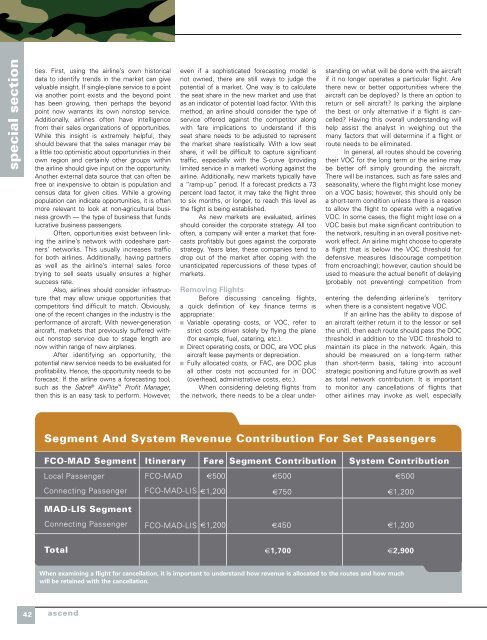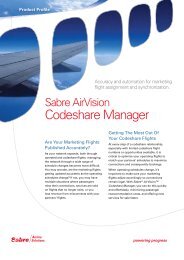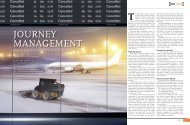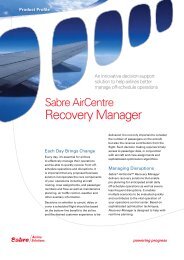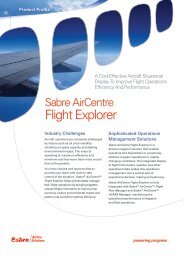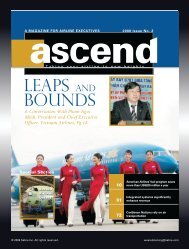2009 Issue 1 - Sabre Airline Solutions
2009 Issue 1 - Sabre Airline Solutions
2009 Issue 1 - Sabre Airline Solutions
You also want an ePaper? Increase the reach of your titles
YUMPU automatically turns print PDFs into web optimized ePapers that Google loves.
special section<br />
42<br />
ties. First, using the airline’s own historical<br />
data to identify trends in the market can give<br />
valuable insight. If single-plane service to a point<br />
via another point exists and the beyond point<br />
has been growing, then perhaps the beyond<br />
point now warrants its own nonstop service.<br />
Additionally, airlines often have intelligence<br />
from their sales organizations of opportunities.<br />
While this insight is extremely helpful, they<br />
should beware that the sales manager may be<br />
a little too optimistic about opportunities in their<br />
own region and certainly other groups within<br />
the airline should give input on the opportunity.<br />
Another external data source that can often be<br />
free or inexpensive to obtain is population and<br />
census data for given cities. While a growing<br />
population can indicate opportunities, it is often<br />
more relevant to look at non-agricultural business<br />
growth — the type of business that funds<br />
lucrative business passengers.<br />
Often, opportunities exist between linking<br />
the airline’s network with codeshare partners’<br />
networks. This usually increases traffic<br />
for both airlines. Additionally, having partners<br />
as well as the airline’s internal sales force<br />
trying to sell seats usually ensures a higher<br />
success rate.<br />
Also, airlines should consider infrastructure<br />
that may allow unique opportunities that<br />
competitors find difficult to match. Obviously,<br />
one of the recent changes in the industry is the<br />
performance of aircraft. With newer-generation<br />
aircraft, markets that previously suffered without<br />
nonstop service due to stage length are<br />
now within range of new airplanes.<br />
After identifying an opportunity, the<br />
potential new service needs to be evaluated for<br />
profitability. Hence, the opportunity needs to be<br />
forecast. If the airline owns a forecasting tool,<br />
such as the <strong>Sabre</strong> ® AirFlite Profit Manager,<br />
then this is an easy task to perform. However,<br />
FCO-MAD Segment<br />
MAD-LIS Segment<br />
Total<br />
even if a sophisticated forecasting model is<br />
not owned, there are still ways to judge the<br />
potential of a market. One way is to calculate<br />
the seat share in the new market and use that<br />
as an indicator of potential load factor. With this<br />
method, an airline should consider the type of<br />
service offered against the competitor along<br />
with fare implications to understand if this<br />
seat share needs to be adjusted to represent<br />
the market share realistically. With a low seat<br />
share, it will be difficult to capture significant<br />
traffic, especially with the S-curve (providing<br />
limited service in a market) working against the<br />
airline. Additionally, new markets typically have<br />
a “ramp-up” period. If a forecast predicts a 73<br />
percent load factor, it may take the flight three<br />
to six months, or longer, to reach this level as<br />
the flight is being established.<br />
As new markets are evaluated, airlines<br />
should consider the corporate strategy. All too<br />
often, a company will enter a market that forecasts<br />
profitably but goes against the corporate<br />
strategy. Years later, these companies tend to<br />
drop out of the market after coping with the<br />
unanticipated repercussions of these types of<br />
markets.<br />
removing flights<br />
Before discussing canceling flights,<br />
a quick definition of key finance terms is<br />
appropriate:<br />
Variable operating costs, or VOC, refer to<br />
strict costs driven solely by flying the plane<br />
(for example, fuel, catering, etc.).<br />
Direct operating costs, or DOC, are VOC plus<br />
aircraft lease payments or depreciation.<br />
Fully allocated costs, or FAC, are DOC plus<br />
all other costs not accounted for in DOC<br />
(overhead, administrative costs, etc.).<br />
When considering deleting flights from<br />
the network, there needs to be a clear under-<br />
standing on what will be done with the aircraft<br />
if it no longer operates a particular flight. Are<br />
there new or better opportunities where the<br />
aircraft can be deployed? Is there an option to<br />
return or sell aircraft? Is parking the airplane<br />
the best or only alternative if a flight is cancelled?<br />
Having this overall understanding will<br />
help assist the analyst in weighing out the<br />
many factors that will determine if a flight or<br />
route needs to be eliminated.<br />
In general, all routes should be covering<br />
their VOC for the long term or the airline may<br />
be better off simply grounding the aircraft.<br />
There will be instances, such as fare sales and<br />
seasonality, where the flight might lose money<br />
on a VOC basis; however, this should only be<br />
a short-term condition unless there is a reason<br />
to allow the flight to operate with a negative<br />
VOC. In some cases, the flight might lose on a<br />
VOC basis but make significant contribution to<br />
the network, resulting in an overall positive network<br />
effect. An airline might choose to operate<br />
a flight that is below the VOC threshold for<br />
defensive measures (discourage competition<br />
from encroaching); however, caution should be<br />
used to measure the actual benefit of delaying<br />
(probably not preventing) competition from<br />
entering the defending airleriine’s€ territory<br />
when there is a consistent negative VOC.<br />
If an airline has the ability to dispose of<br />
an aircraft (either return it to the lessor or sell<br />
the unit), then each route should pass the DOC<br />
threshold in addition to the VOC threshold to<br />
maintain its place in the network. Again, this<br />
should be measured on a long-term rather<br />
than short-term basis, taking into account<br />
strategic positioning and future growth as well<br />
as total network contribution. It is important<br />
to monitor any cancellations of flights that<br />
other airlines may invoke as well, especially<br />
Segment And System Revenue Contribution For Set Passengers<br />
Local Passenger<br />
Connecting Passenger<br />
Connecting Passenger<br />
Itinerary Fare Segment Contribution System Contribution<br />
FCO-MAD<br />
€500<br />
FCO-MAD-LIS €1,200<br />
FCO-MAD-LIS €1,200<br />
€500<br />
€750 €1,200<br />
€450<br />
When examining a flight for cancellation, it is important to understand how revenue is allocated to the routes and how much<br />
will be retained with the cancellation.<br />
ascend<br />
€500<br />
€1,200<br />
€1,700 €2,900


